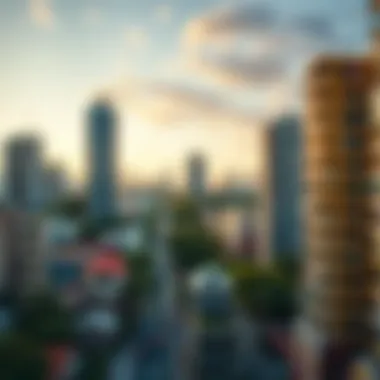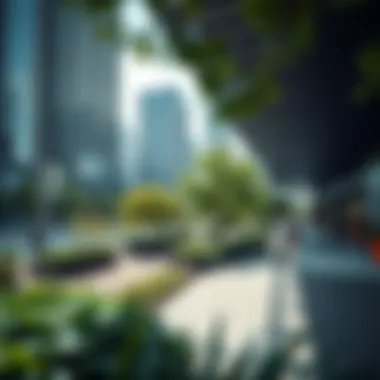Cityscape 2023: Trends Shaping Urban Environments


Intro
Urban environments are in a constant state of flux, adjusting to new realities brought about by technology, societal shifts, and economic trends. 2023 stands as a pivotal year that marks significant transformations in cityscapes across the globe. From retrofitted historical buildings that preserve the past to towering smart skyscrapers equipped with the latest in renewable energy technologies, cities are evolving into multi-dimensional spaces that cater to diverse populations and industries.
In this article, we delve into the elements that are reshaping our cities and what these changes mean for various stakeholders—investors, home buyers, real estate professionals, and developers. By examining architectural trends and the social factors intertwined with these shifts, we hope to provide a thorough understanding of today’s urban landscape. The insights gleaned from this exploration serve not only to enhance awareness but also to guide decisions in the dynamic real estate sector.
Through a detailed analysis, we'll identify the market insights that are crucial for making informed investments—considering property prices and forecasting potential growth. Additionally, we’ll highlight prime areas for real estate investment and offer calculations on return on investment (ROI) and yield metrics that investors often seek.
This is a journey through urban transformation, a look into how design, sustainability, and economic factors are colliding to create the cities of tomorrow.
The Concept of Cityscape
Understanding the concept of cityscape is crucial for anyone navigating the complexities of modern urban living, whether it be an investor, homebuyer, real estate agent, developer, or market analyst. Cityscapes are not just collections of buildings; they represent the interconnectedness of culture, commerce, and community within a geographical area. In 2023, as cities worldwide continue to evolve, grasping the essence of what cityscapes entail can unlock various insights into potential trends, opportunities, and challenges.
Defining Cityscape
A cityscape encapsulates the visible features of a city—its architecture, infrastructure, and the broader urban environment. It merges natural and human elements into a cohesive aesthetic, offering a lens through which we can understand the life within a city. Think about the sprawling skylines like that of New York or the sun-soaked boulevards of Los Angeles; they evoke feelings, memories, and even aspirations. Importantly, a cityscape mirrors the socioeconomic fabric and reflects historical significance, lifestyle choices, and cultural values of its inhabitants.
For instance, consider the mix of modern developments and historic districts in cities like Berlin, highlighting not just progress but also a respect for the past.
- Urban Aesthetics: The interplay of buildings, parks, and streetscapes that creates a city's personality.
- Functional Aspects: The infrastructure that supports daily life, such as transportation systems, public spaces, and housing.
- Cultural Identity: The distinctive features that communicate the values and history of a locale, whether through street art, architectural styles, or community events.
Historical Evolution of Urban Landscapes
Urban landscapes have a storied history, evolving in accordance with technological advancements, economic shifts, and societal changes. To appreciate modern cityscapes, one must look back at how urban development has transformed over the centuries.
From ancient cities like Rome and Athens, where urban planning was minimal, to the rise of industrial cities in the 18th and 19th centuries that prioritized functionality and efficiency, the trajectory of urban growth reflects human ingenuity and adaptability.
Consider the following key periods:
- Ancient Civilizations: Cities were often designed for defense, with walls and limited access. Their layout relied heavily on geography, as seen in places like Cairo, built around the Nile River.
- Industrial Revolution: With the boom in industry, cities expanded rapidly. Factories, railroads, and mass housing changed the urban landscape dramatically, creating areas with distinctive socioeconomic challenges—issues still relevant today.
- Post-World War II: Urban renewal projects and suburbanization reshaped cityscapes into sprawling areas, often prioritizing cars over people with wide roads and shopping malls.
- Modern Era: The last few decades have ushered in a focus on sustainability, mixed-use developments, and smart technology integration that redefine urban living.
As we glimpse into 2023, it's essential to analyze these historical trajectories to understand present-day challenges and opportunities within urban environments. Each evolution has brought with it uncharted territories for investment, cultural expression, and sustainable living. This context sets the stage for why cityscape is more than just a backdrop—it’s an ongoing story of human expression and interaction.
Technological Advancements Shaping Cityscapes
In 2023, technology is reshaping urban environments in profound ways. With the relentless pace of urbanization worldwide, the integration of innovative technologies in city planning and design is more crucial than ever. The aim is not only to enhance the livability of urban areas but also to streamline operations, making cities more efficient and resilient against the pressures of modern life.
Smart City Technologies
The concept of a smart city is at the forefront of urban development. Smart technologies encompass a variety of solutions aimed at optimizing city services and infrastructure. IoT sensors, for instance, are increasingly being deployed to monitor traffic flows, air quality, and energy consumption, providing real-time data that helps municipalities make informed decisions.
Benefits abound, including improved traffic management, better waste management systems, and enhanced public safety. Imagine a scenario where streetlights adjust automatically based on pedestrian movement or traffic patterns—this is no longer a mere dream but a reality in forward-thinking cities everywhere.
- Data-Driven Decision Making: City planners can analyze vast amounts of data to identify trends and patterns, leading to more effective urban policies.
- Enhanced Public Transportation: Real-time updates mean that public transport systems can adapt quickly to passenger demand, reducing wait times and congestion.
- Eco-Friendly Solutions: Innovations such as smart grids contribute to energy efficiency, promoting lower carbon footprints and sustainability.
As we explore smart city technologies, it’s essential to remain cognizant of potential challenges. Data privacy and security concerns often arise, demanding robust frameworks to safeguard citizens’ information while fostering transparency.
Impact of AI and Automation
Artificial Intelligence (AI) and automation are revolutionizing not just the workplace but our urban landscapes as well. These advancements can be seen in various sectors, such as public safety, traffic management, and service delivery. AI algorithms can process astronomical amounts of data instantly, identifying problems and suggesting solutions.
For investors, the implications are significant. The integration of AI into urban management can lead to increased property values and improved urban amenities.
Some key points to consider include:
- Predictive Maintenance: AI can forecast when infrastructure needs repairs, reducing costs and downtime.
- Automated Public Services: From trash collection to street cleaning, automation can help city services become more efficient.
- Enhanced Emergency Response: AI systems analyze situations in real-time, aiding first responders in making critical decisions promptly.
The future of cityscapes lies in the thoughtful application of technology, paving the way for innovation that meets the needs of urban populations.


In closing, the interaction between smart technologies and AI illustrates a broader trend of adaptability and foresight in urban planning. As cities evolve, it’s essential for investors, home buyers, and other stakeholders to engage with these advancements, leveraging the opportunities they bring to navigate the complexities of city life more effectively. Understanding these innovations will aid in making informed choices about property and investment in the dynamic urban landscape.
Sustainable Urban Development
Sustainable urban development is crucial in today's rapidly changing urban environment. As cities burgeon, the demands on resources and infrastructure grow exponentially. This section sheds light on pivotal aspects of sustainable urban development, including the benefits it brings to communities, the environment, and economics.
A major benefit of sustainable urban development is the ability to create resilient communities. By using smart design principles, cities can minimize their carbon footprints while maintaining functional urban spaces. This involves integrating renewable energy sources, developing efficient public transportation systems, and creating green spaces that enhance biodiversity. Such initiatives not only benefit the environment but also enhance the quality of life for residents.
Furthermore, sustainable practices can lead to economic growth. By investing in eco-friendly technology and infrastructure, cities can attract both investors and residents. More people are drawn to neighborhoods that prioritize sustainability, driving up real estate values and creating a robust job market.
Another aspect to consider is the social responsibility aspect. As urban planners and developers implement sustainable practices, they contribute to social equity. Affordable housing initiatives, access to public amenities, and transparent decision-making processes foster community engagement and mitigate socioeconomic disparities.
Let's break down some underlying components:
- Efficient Land Use: Cities are expanding horizontally and vertically. Utilizing land wisely allows urban planners to preserve open space while accommodating residential, commercial, and industrial needs.
- Transportation Solutions: Developing integrated public transport networks reduces dependency on personal vehicles, thus lowering greenhouse gas emissions.
- Water and Waste Management: Efficient systems for water conservation and waste reduction lead to a cleaner environment and better resource utilization.
In summary, sustainable urban development not only focuses on eco-friendliness but also intertwines economic growth with social equity. As we navigate the challenges of urbanization, this approach will remain indispensable in shaping livable cities for future generations.
Green Architecture Trends
Green architecture continues to grow in prominence as a response to the pressing need for eco-friendly construction and designs. With an emphasis on energy efficiency and reduced environmental impact, various trends are shaping the landscape of modern architecture.
One notable trend is passive design, which emphasizes natural light, ventilation, and temperature regulation. Buildings designed with passive principles utilize building orientation, thermal mass, and strategic landscaping to reduce the dependence on artificial heating and cooling systems.
Another emerging trend is the adoption of biophilic design principles. This approach integrates natural elements into urban environments, promoting psychological well-being, community cohesion, and biodiversity. Examples include green roofs, living walls, and open-air spaces that incorporate native plant species.
Moreover, the use of sustainable materials like bamboo, reclaimed wood, and recycled metals is gaining traction, reducing the carbon impact of new constructions. Additionally, innovative technologies such as solar panels and rainwater harvesting systems are more accessible than ever, allowing even small-scale developments to incorporate green technologies.
Incorporating these trends plays a significant role in shaping cities that prioritize health and sustainability. Not only do such measures support environmental goals, but they also align with the increasing demand from buyers and investors for eco-conscious properties.
Challenges in Sustainability
Despite the clear benefits, sustainable urban development faces numerous challenges that can hinder progress. Navigating these obstacles requires strategic planning and collaboration among various stakeholders.
One of the primary challenges is the initial cost of sustainable projects. Although long-term savings can be substantial, upfront investments may deter developers and investors. Skimping on sustainable materials or energy-efficient systems, to cut costs initially, can lead to increased operational expenses down the line.
Furthermore, there are regulatory and policy hurdles. Various jurisdictions have different sustainability goals and building codes, creating confusion. Developers often struggle to navigate these regulations; inconsistent standards can slow down or even halt projects.
Community resistance is another significant obstacle. Many neighborhoods may be hesitant to embrace new development, particularly if it means changing the character of their area. Public engagement and education are vital to address aspirations and alleviate concerns.
Additionally, the global economic landscape can introduce volatility. Instability in markets can limit funding for sustainable initiatives, which rely heavily on public and private investment.
The interplay of these challenges makes sustainable urban development a complex endeavor requiring perseverance and innovative solutions. Nevertheless, addressing these issues is essential for creating cities that support both people and the planet.
Case Studies in Sustainable City Planning
Examining successful case studies provides valuable insights into effective sustainable urban development strategies. Copenhagen, Denmark, is often hailed as a leader in green city planning. The city has committed to becoming climate-positive by 2025 and has implemented extensive cycling infrastructure and renewable energy initiatives.
Another example is Portland, Oregon, where dense urban development and comprehensive public transportation have created a vibrant hub. Their investment in green building codes has resulted in numerous eco-friendly structures, making them a model for other cities.
Lastly, Singapore stands out through its innovative integration of nature within the urban environment. Their Garden City vision fosters green spaces and biodiversity, transforming the urban landscape into a blend of concrete and greenery while enhancing air quality and public health.
These case studies spotlight the effectiveness of specific strategies while revealing the importance of collaboration, monitoring, and adaptability. They also illustrate that sustainable urban development can yield considerable economic and social benefits while addressing environmental challenges.
Economic Factors Influencing City Landscapes
Economic dynamics play a crucial role in shaping urban environments. They not only influence the way cities develop but also affect how communities interact within them. Home buyers, developers, and real estate agents must recognize these factors to navigate the urban landscape effectively. In 2023, the interplay between the economy and cityscapes is more pronounced than ever, with real estate trends and investment opportunities taking center stage.
Real Estate Market Trends


The real estate market has always been a barometer of economic health. Currently, trends indicate shifts towards more affordable housing options and sustainable living spaces. Urban areas, having seen explosive growth in property values, are shifting gears. Affordability is becoming a key consideration for many.
- Supply and Demand: Cities are experiencing fluctuating demand. A growing population in metropolitan areas drives the need for housing. However, construction delays and regulations can hinder the supply side, creating volatility in property prices.
- Remote Work: The pandemic opened doors for flexible working arrangements. Many are now prioritizing space over location, resulting in a trend where suburban and rural areas are seeing a real estate boom. Buyers are looking for homes with dedicated workspaces, backyards, and room to grow.
- Commercial Real Estate: A noticeable shift is also happening here, with businesses reevaluating their need for large office spaces. The rise of hybrid models means that many operators are downsizing or repurposing existing space, impacting urban economic dynamics.
In this environment, it’s essential for investors to keep an eye on market analytics that can signal emerging trends. For instance, sites like Zillow or Realtor.com provide localized market insights that can guide purchasing decisions.
Investment Opportunities in Urban Areas
Investing in urban properties can be a goldmine if approached with knowledge and foresight. Understanding the economic landscape can unveil valuable opportunities. Here are some trends shaping investment decisions in 2023:
- Regeneration Projects: Many cities are investing in redevelopment initiatives aimed at revitalizing declining neighborhoods. These areas often have lower entry costs but hold significant potential for appreciation.
- Mixed-Use Developments: The trend towards combining residential, commercial, and recreational spaces is gaining traction. Investors can benefit from multiple income streams and reduce vacancies.
- Sustainable Developments: Urban areas are increasingly prioritizing green initiatives. Properties that incorporate energy-efficient designs and sustainable materials are now more attractive to conscious buyers and tenants alike.
Investors should scrutinize local policies and incentives related to sustainable development. Websites like Urban Land Institute can provide wealth of information regarding trends and discussions surrounding urban real estate.
Urban Design and Architecture in
Urban design and architecture play a significant role in shaping the future of cities as they become more vibrant, accessible, and sustainable. The urban fabric reflects cultural values, social dynamics, and economic considerations, making it pivotal in the modernization of cityscapes. In 2023, these practices are not just about aesthetics; they greatly impact the quality of life for residents, influence real estate trends, and attract investment.
In this rapidly evolving landscape, the importance of thoughtful urban design cannot be overstated. It fosters community interaction, encourages sustainability, and integrates technology in ways that enhance urban living. For investors and developers, understanding these aspects is vital in making sound decisions that align with current and future urban needs.
Contemporary Architectural Styles
The architectural styles emerging in 2023 are as varied as the cities they inhabit. Here are a few noteworthy trends:
- Biophilic Design: This style emphasizes the connection between nature and urban living, featuring elements like green walls, ample natural light, and organic shapes. It promotes well-being and reduces the urban heat island effect.
- Minimalist Architecture: Clean lines and open spaces define minimalism, leading to simpler, yet more functional living environments. This approach reduces construction costs and is often more sustainable because it uses fewer materials.
- Adaptive Reuse: This is a growing trend where old structures are transformed into new spaces, reducing waste and preserving cultural heritage. From warehouses turned into trendy lofts to factories converted into community centers, adaptive reuse breathes new life into forgotten spaces.
- Smart Buildings: These structures use technology for efficient energy management, comfort, and security. Incorporating features like automated lighting and HVAC systems, smart buildings are becoming part of the urban landscape.
Each style reflects a shift towards more sustainable, practical, and community-oriented design. Investors keen on understanding these styles can better predict market trends and identify opportunities in real estate.
Role of Public Spaces in Urban Environments
Public spaces are the heart of urban design, offering vital social interactions and community engagement opportunities. Areas like parks, plazas, and community centers are designed to be inclusive and accessible for all. Their significance in 2023 can be summarized as follows:
- Social Cohesion: Well-designed public spaces bring diverse populations together, fostering a sense of community. Open-air markets and festival spaces enable cultural exchange and strengthen local identity.
- Economic Benefits: Communities with vibrant public areas often see increased foot traffic, benefiting local businesses. Successful urban designs enhance the economy by attracting tourism and investment.
- Health and Well-being: Access to green spaces has been linked to improved mental and physical health. Cities that prioritize such designs create environments conducive to healthier lifestyles, which can reduce healthcare costs long-term.
- Mobility and Connectivity: Public spaces often serve as hubs for transportation and social activities. With improved pedestrian paths and bike lanes, cities promoting walkable areas can reduce congestion and elevate overall urban mobility.
Public spaces are essential for community engagement, providing venues where urbanites can connect, learn, and thrive.
To dive deeper into these topics, consider visiting resources such as Wikipedia, Britannica, or Reddit, where discussions on urban design continually evolve.
Cultural Influences on Cityscapes
Cityscapes are not just a collection of buildings and roads; they are living reflections of the culture and identity of their inhabitants. Understanding the role of cultural influences in shaping urban landscapes is essential for a comprehensive view of how cities grow and change. It's like a mosaic where every tile represents the stories, traditions, and aspirations of the people who call that city home. These cultural elements ensure that cities are not just functional spaces, but vibrant ecosystems of life, creativity, and social interaction.
Diversity in Urban Areas
Urban areas are increasingly known for their diversity, encompassing a mix of ethnicities, backgrounds, and ways of life. This varied tapestry has profound implications on city development. Every community adds its color to the overall picture, influencing everything from food markets to festivals.
- Vitality of Neighborhoods: Cities that promote diversity often see greater economic activity. Local businesses thrive when they cater to a rich array of tastes and preferences. For instance, take Little Italy in New York City or the Chinatowns across various major cities. These neighborhoods not only serve as cultural hubs but also attract tourists, creating a cycle of economic vibrancy.
- Social Cohesion: A diverse urban area helps foster a sense of belonging among its residents. Festivals, cultural events, and communal spaces are often born out of various cultural influences, allowing different groups to share their heritage and traditions. This engagement helps break down barriers, leading to stronger community bonds.
- Innovative Solutions: A mix of cultures brings together different perspectives, leading to innovative approaches in urban planning. The integration of unique cultural practices into city design can enhance public spaces, making them more inclusive and reflective of the city's identity.
Art and Its Role in Urban Identity
Art serves as a powerful medium through which the unique identity of a city is expressed. It has the potential to tell stories, provoke thought, and inspire connection among people. This integration of art into urban landscapes shapes the identity of cities in myriad ways, creating spaces that resonate with the community.
- Public Art Installations: Murals, sculptures, and performance spaces contribute to the aesthetic appeal of an urban area. Cities like Los Angeles are famous for their street art, which not only beautifies but also speaks to social issues, making urban art a powerful tool for visual expression and dialogue.
- Cultural Significance: Art events or festivals often reflect the history and culture of an area, such as the Venice Biennale in Italy. They can draw international attention, positioning cities on the world stage and attracting tourism related to cultural experiences.
- Community Identity: Local artists often embody the struggles and triumphs of their neighborhoods through their work. This can lead to a greater appreciation for local heritage and history. Spaces that embrace this art can encourage residents to feel a stronger connection to their community, influencing their overall quality of life.
"A city without art is like a body without a soul."
Art, in all its forms, enriches urban landscapes, making them not only living habitats but stories waiting to be told, deeply intertwined with the local culture.
In essence, cultural influences are vital elements that shape the dynamics of cityscapes. Understanding these facets is crucial for stakeholders such as investors, home buyers, and real estate agents, who must navigate both tangible assets and the intangible fabric of community identity as they explore opportunities in urban areas. For further insights on city diversity, explore resources like Wikipedia, and for deeper community engagement strategies, check socialimpact.org.


Social Dynamics of Urban Life
Understanding the social dynamics of urban life is crucial as cities evolve into multifaceted entities. The interconnections between various community members, the influence of demographics, and the interplay of social organizations shape not just the urban landscape but also the daily lives of individuals. As cityscapes become increasingly complex, comprehending these dynamics is essential for investors, real estate professionals, and developers aiming to navigate the often treacherous waters of urban economics.
The growing urban population leads to diverse interactions among residents, creating a new social fabric. This diversity enriches the urban environment but also presents challenges that can affect property markets and local economies.
Community Engagement and Participation
In today's urban centers, community engagement is more than an afterthought; it’s an essential pillar upon which vibrant neighborhoods stand. When residents actively participate in local events, town meetings, and volunteer opportunities, the sense of belonging grows stronger. This camaraderie leads to residents who look out for one another. Here’s why this matters:
- Stronger Neighborhoods: Active participation fosters stronger social ties, reducing crime rates and increasing safety, which is a boon for property values.
- Improved Infrastructure: Communities that engage often collaborate with local governments, pushing for improvements in infrastructure that directly enhance real estate appeal.
- Sustainability Initiatives: Participation often leads to initiatives that prioritize sustainability, making neighborhoods more attractive to eco-conscious buyers.
Yet, gaining engagement is not without its hurdles. Many urban areas face apathy or mistrust towards local governments. Building bridges to overcome these can be a complex process, requiring understanding and innovation.
Socioeconomic Disparities in Urban Environments
Urban environments are often microcosms reflecting broader societal disparities. The economic divide between the affluent and less fortunate can be stark and may pose significant challenges to city development. This discrepancy affects everything from access to quality housing to educational opportunities and health services.
Key points in understanding these disparities include:
- Housing Market Pressures: Gentrification leads to rising property values, which can push lower-income residents out of their neighborhoods, altering the demographic make-up. This can create tensions and lead to social fragmentation.
- Access to Resources: Economic disparities can limit access to essential resources. Poorer neighborhoods may struggle with inadequate public transport, limited healthcare facilities, and underfunded schools.
- Investment Inflows: Areas with socioeconomic challenges can become attractive to investors if strategic investments in infrastructure and community services are made. Understanding local dynamics is key to making effective investments in these spaces.
The Future of Cityscapes
The future of cityscapes is a topic that resonates with relevance and urgency. As our urban environments evolve, it’s essential to consider how the intricate threads of technology, sustainability, and socio-economic dynamics weave together, shaping what lies ahead. The landscape of our cities is not just about architecture; it encompasses innovative solutions to prevailing issues, dynamics of local communities, and the implications of global phenomena. Understanding these elements can equip investors, homeowners, and decision-makers with the tools needed to navigate the expansive and often tumultuous terrain of urban development.
Predicted Trends for Urban Development
Urban development is poised for transformative shifts in the coming years. A few key trends are expected to dominate:
- Smart Infrastructure: Cities will increasingly integrate smart technologies. This includes sensor-driven public services to enhance the quality of life and streamline operations. From traffic management to energy efficiency in buildings, technology is becoming the backbone of urban living.
- Mixed-Use Developments: These are set to gain more traction, promoting the blending of residential, commercial, and recreational spaces. This lifestyle encourages community interaction, reducing dependence on vehicles, and enhancing urban cohesion.
- Eco-Friendly Practices: Sustainability will be at the forefront of architectural design. Expect to see buildings featuring renewable energy sources and eco-friendly materials, reflecting a global commitment to combating climate change. Structures like passive houses that maximize energy efficiency will likely flourish in demand.
- Flexible Living Spaces: The trend towards remote work has reshaped how city spaces are utilized. Young families might seek adaptable living arrangements or co-living spaces that accommodate shifting job landscapes and lifestyle choices.
These trends can potentially alter desirable locations for investment, prompting a need for keen observation and adaptability.
Adapting to Global Challenges
As we look toward the future of cityscapes, adapting to global challenges becomes paramount. Some considerations include:
- Climate Resilience: Rising sea levels, increased natural disasters, and extreme weather require urban planners to rethink infrastructure. Cities will need to prioritize designs that can withstand future environmental stresses.
- Economic Disparities: The gap between different socio-economic groups remains a pressing issue. Solutions must include affordable housing initiatives and accessible public services to promote equity within urban settings.
- Technological Equity: As technology permeates city life, ensuring equitable access to its benefits becomes vital. Bridging the digital divide is an ongoing struggle that must be acknowledged as cities forge ahead.
- Public Health: The recent health crises have showcased the necessity for urban spaces that amplify public health outcomes. This includes planning for improved air quality, green spaces for mental health, and accessible health services.
Thinking ahead means accepting these challenges. Effective responses can lead to robust and vibrant urban ecosystems.
"Municipalities are on the front lines of addressing pressing global issues within the context of local challenges, making it essential to plan with foresight and creativity."
By analyzing these predicted trends and challenges, stakeholders can work collaboratively toward creating urban environments that not only meet today’s needs but are also resilient enough to navigate tomorrow’s uncertainties.
Ending: The Path Forward for Urban Development
As we stand at the juncture of urban evolution in 2023, it is paramount to deliberate on the future pathways for urban development. This segment ties together all the intricate themes discussed throughout this article, from technological shifts to sustainable initiatives. Understanding that urban landscapes are not static but dynamic is essential for all stakeholders, including investors, home buyers, and real estate professionals. One must recognize that to navigate this urban symphony effectively, a strategic vision must be embraced.
Reflections on Cityscape Evolution
The metamorphosis of cityscapes over recent decades is nothing short of remarkable. From sprawling suburban developments birthed in the mid-20th century to the contemporary smart city initiatives emerging today, each phase reflects broader societal shifts. Urban centers like Singapore and Barcelona exemplify this evolution by integrating technology to enhance livability while addressing environmental concerns.
- Increased Emphasis on Sustainability: There is a persistent shift towards eco-friendly designs that harmonize with nature. Green roofs, solar panels, and efficient public transit are not just luxuries anymore; they’re necessities that cities cannot afford to overlook.
- Cultural Resonance: Cities thrive on their diversity and cultural identities. The amalgamation of different backgrounds adds rich layers to the urban tapestry. Recognizing and fostering this cultural wealth will be key in shaping future urban identities.
- Adaptation to Change: Whether it’s climate change or rapid technological advancement, cities will need to adapt quickly. Successful urban planning will likely blend flexibility with forward-thinking solutions.
"The real challenge isn’t just to build cities; it’s about creating spaces that encompass the needs of today while anticipating the desires of tomorrow.”
Call for Strategic Urban Planning
In light of the rapidly evolving urban environment, the need for strategic urban planning has never been more pressing. A well-crafted plan integrates various elements: economic, social, and technological. It is not merely about setting rules and regulations, but rather about envisioning a thriving urban ecosystem.
- Inclusivity in Planning: Urban development must prioritize the voices of the community. Engaging local populations ensures the spaces created are relevant and meet the actual needs of the populace.
- Long-Term Visioning: Strategies should be future-proof, taking into account possible shifts in population, climate conditions, and technological advancements.
- Collaborative Governance: Integrating efforts from government, private sector, and community organizations can yield more effective solutions. Communication and collaboration breed innovation and can help address complex urban challenges.
For further insights, consider exploring Wikipedia on Urban Development, or check out Britannica’s articles on City Planning.
This pathway towards a coherent urban future never ceases to present possibilities—let's embrace them.











